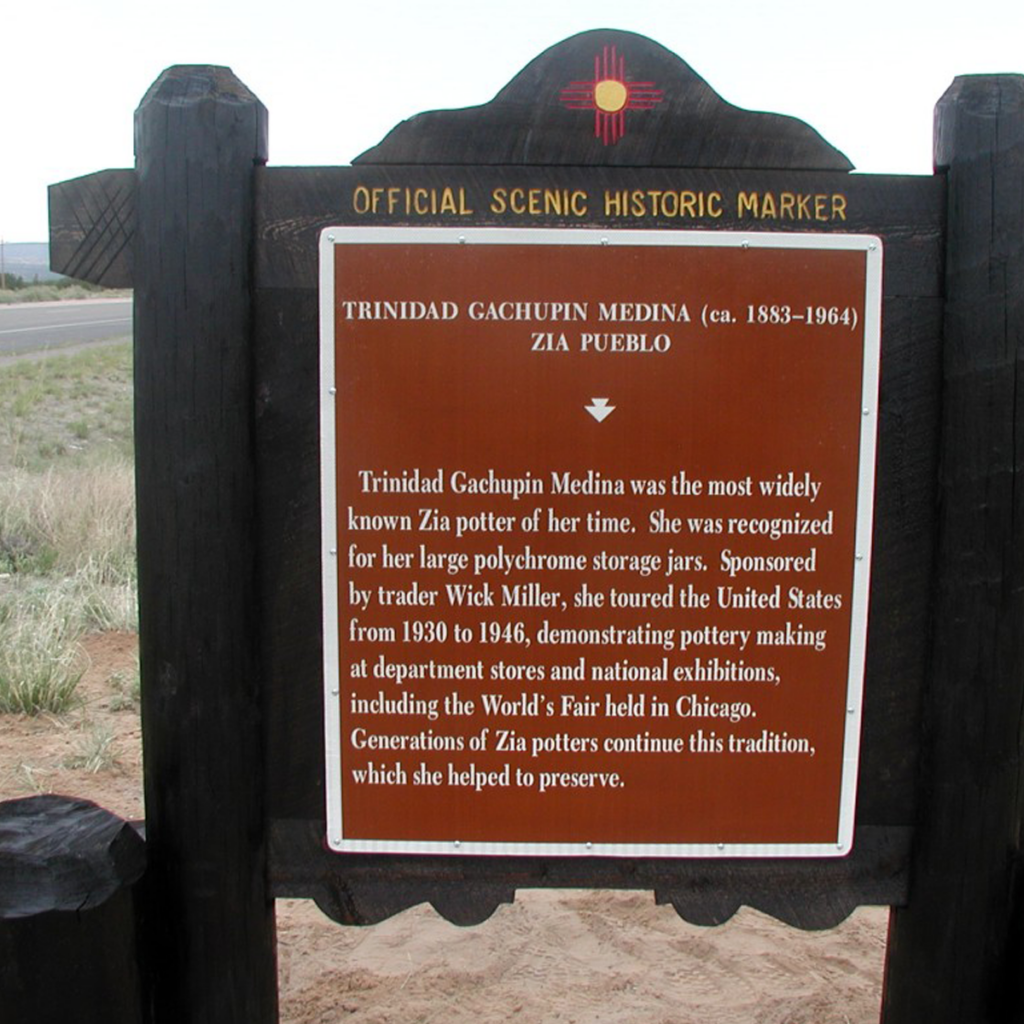Virginia T. Romero historic marker.
Photo Credit: Courtesy of New Mexico Historic Women Marker Program.
Virginia T. Romero
1896 - 1998
Taos County
The mother of ten children, she supported her family by selling her micaceous pots to locals and tourists, ultimately helping preserve the micaceous pottery tradition. Still valued for their utility, these pots are now also considered works of art and appear in museum collections throughout the country.
Virginia T. Romero was a prominent Taos potter who helped to keep micaceous pottery alive in her community. Micaceous pots are excellent for cooking and are renowned for their ability to retain heat. In recent years, collectors and museums have recognized these pots for their artistic value.
A mother of ten, Romero supported her family by selling pots to locals and tourists. Like other Pueblo potters, she likely learned to make pottery by observing women in her family and community. She used traditional potting and firing techniques that have become threatened by the availability of non-traditional clays and firing technologies. She spoke proudly of never losing a pot during the outdoor firing process since she first started making pottery in 1919. She attributed this success to her clay, which she ground to a fine mixture.
Taos is a Tiwa speaking Pueblo located in northern New Mexico. With its multi-tiered adobe buildings still intact, Taos has been designated a UNESCO World Heritage Site and attracts many visitors each year. Taos potters, like those from nearby Picuris Pueblo, gather their clay from the local mountains to form handmade micaceous pots. Micaceous pottery can now be found outside of Taos and Picuris as potters from other pueblos have adopted use of the mica-rich clay. Jicarilla Apaches are also renowned for their micaceous pottery.
Taos and Picuris are known for their famous micaceous “bean pots,” which are good for cooking beans. Romero noted that her pots could be used over an open stovetop flame. Micaceous pots can also be used in the oven. The mica in the clay makes these pots excellent for retaining heat. Oil can be used as a sealant to protect the food from tasting “earthy.”
Taos, like Picuris, made decorated pottery before the Pueblo Revolt of 1680. Unlike pottery styles from other Pueblos, micaceous pots are generally unpainted except for incised patterns and decorative relief, such as clay beads, ribbons, lizards and other animal figures. Micaceous pots come in a variety of shapes and sizes. Some potters make figures with micaceous clay such as animals and nativity scenes. Bean pots often have handles or lids, which range from the simple to the elaborate. Smoke stains or “fire clouds” acquired during the firing process further differentiate pots. Some potters rub a slip of mica on their pots before firing, but Romero did not add anything to her clay mixture. She noted that she did not polish her pots but simply shaped and smoothed them out.
Still valued for their utility, mica pots are now also considered works of art and appear in museum collections throughout the country. Although micaceous pottery is primarily associated with Taos, Picuris, and the Jicarilla Apaches, potters from other Pueblo communities are now working with micaceous clay and continue a tradition that Virginia T. Romero was active in preserving for future generations.
Sources:
Anderson, Duane. All That Glitters: The Emergence of Native American Micaceous Art Pottery in Northern New Mexico. Santa Fe:School of American Research Press, 1999.
Barry, John W. American Indian Pottery: An Identification and Value Guide. 2d. Edition. Florence, AL:Books Americana, 1984.
Trimble, Stephen. Talking with the Clay: The Art of Pueblo Pottery. Santa Fe:School of American Research Press, 1987.
Text provided by Bernadette Romero, granddaughter (unpublished biographical information, 2008), New Mexico Historic Women Marker Initiative archive.
Directions:
Virginia T. Romero
Taos County
Artist | Cultural preservationist | Educator |
Statehood (1912 - present) | Territorial Period (1848 - 1912) |
North Central







